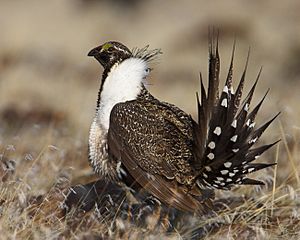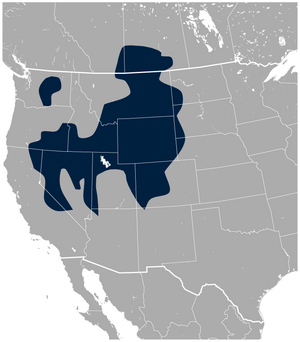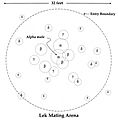Greater sage-grouse facts for kids
Quick facts for kids Greater sage-grouse |
|
|---|---|
 |
|
| Male in USA | |
| Conservation status | |
| Scientific classification | |
| Subspecies | |
|
|
 |
|
| Sage grouse range |
The greater sage-grouse (Centrocercus urophasianus) is the largest grouse in North America. It lives in the western half of the United States and the Alberta and Saskatchewan provinces. They are larger than a pheasant but smaller than a wild turkey.
They belong to the Phasianidae family. The Gunnison sage-grouse (Centrocercus minimus) is the other species in the genus.
Contents
Populations
At one time they numbered in the millions. Because of loss of the loss of sagebrush habitat there are now between 200,000 to 500,000 birds in the western US. They are now being considered for listing under the Endangered Species Act (ESA). In Canada It is estimated their habitat range has been reduced by 90%. They are completely gone from British Columbia. It is estimated the population in Canada was reduced by 88% between 1988 and 2006.
Courtship
In the spring, during their breeding season, male sage-grouse gather to do their courtship displays. They do this on areas called "leks". As the males dance they make a popping sound. This is done by inflating and deflating their two yellow throat sacs. They display their pointed tail feathers while they strut. As many as a dozen males may dance at the same time. Sometimes two males will fight with their wings. The hens will watch for several days before picking out a mate. They make their nests in the sagebrush. The males do not help with nesting or with raising chicks.
Images for kids
-
Lek mating arena, in which each male guards a territory of a few meters in size on average, and in which the dominant males may each attract up to eight females. In addition, each individual is shown with variations in personal space (bubbles), whereby higher-ranking individuals have larger personal space bubbles. Common bird leks typically have 25–30 individuals. A strict hierarchy accords the most desirable top-ranking males the most prestigious central territory, with ungraded and lesser aspirants ranged outside. Females come to these arenas to choose mates when the males' hierarchy has become established, and preferentially mate with the dominants in the centre.
See also
 In Spanish: Centrocercus urophasianus para niños
In Spanish: Centrocercus urophasianus para niños




